A multitude of emotions and thoughts besiege a bowhunter in the immediate aftermath of the successful strike of an arrow; elation, a sense of accomplishment, an appreciation of the animal and the experience, maybe even shakiness as the adrenaline rush recedes. Usually too, concerns about the length and difficulty of the trail pop into the archer’s mind. Right at this exact moment, a hunter can note four places that may later be helpful in finding the game; his or her location at the time of the shot (simple when one is in a stand, worth marking when one is on the ground), the exact place the animal was impacted, the last places the animal was seen and heard. Memorize these spots precisely. Take compass bearings if no definitive landmarks can be ascertained. Hopefully, the trail is blatant and easily followed, but if it becomes troubling, knowledge of these places may come in handy.
Trailing the stricken game is a skill that can be enjoyable and rewarding. The more methodical the tracker, the greater the chances for success. Many trails are simple with copious and obvious blood and require little advanced technique, but treating each one methodically will pay dividends should a trail suddenly become tricky, and also provides experience that may be of use in future trails.
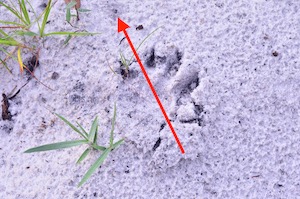
The sand pushed up and broken on the bottom right side of this raccoon track alerts the tracker to search for the next track above and to the left of this one rather than in the direction the claws point. (See arrow)
The first place for scrutiny is the impact site. Look for hair, blood, tracks, and the arrow if it passed through. Clues can be gleaned from each of these as to the location and lethality of the wound. Most people recommend waiting at least 45 minutes before starting a trail. In truth, the best course depends on the wound and on other factors and can vary considerably but we can accept that guideline for the purpose of this article. The term ‘blood trailing’ has been universally adopted, but unfortunately, leads many bowhunters to focus their efforts solely upon finding blood. The methodical tracker instead focuses on searching for any evidence of the animal’s passage.
Tracks created by the initial spring of the animal indicate the direction of its flight. The substrate around the track will be pushed up higher or crumbled more extremely where force was applied to propel the animal. Therefore, a line through the track directly away from this raised or fractured border steers the tracker toward the next place the animal’s feet touched the ground. This may not be the direction the tips of the track seem to point. The same is true of future tracks and when the most prominent evidence of force is not directly behind the track, expect a directional change. As long as the fleeing animal maintains the same rate of speed, the stride length will remain equal. This fact allows the tracker to narrow the search area for the next track by measuring the stride length initially. The distance can then be paced, or a branch or sapling, cut to the proper length, employed. (People who track regularly often make adjustable tracking sticks for this purpose.) Knowing the stride length precisely can also alert a tracker to a change in pace which may signify a coming change of direction or perhaps the end of the trail.
As with looking for blood sign, the search for tracks should not narrow or limit the tracker’s focus. Any blood, overturned leaves or stones, broken sticks, the undersides of the leaves of ground vegetation, or bent grasses should be noted. When any of these or other indications of flight are seen, the tracker should remain still and search beyond the sign for a continuation of the trail. Very often, especially with bent grasses or where dew or rain has wetted the vegetation, the trail will be exceptionally visible for a long distance. Even blood droplets can sometimes be descried farther along the trail in this manner.
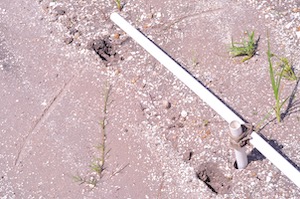
A tracking stick adjusted to the correct stride length where tracks are obvious helps pin-point where to look when the terrain makes tracks harder to see.
Not always, yet surprisingly often, even with good shots, blood is not discovered on the first bit of the trail; hence the importance of noting the last place the animal was seen and studying its tracks. Once blood is found, frequently tracking becomes much simpler as bright, red blood is easier to discern than faint tracks or altered ground cover. With the excitement of the occasion, the temptation is to progress as quickly as possible. When the blood sign or other evidence is readily observable, no harm arises from succumbing. However, should the sign diminish, prudence suggests immediately slowing the pace. The tracker or trackers themselves disrupt the normal condition of the terrain. If the trail is lost, any attempt to rediscover it can be hampered by sign left by the trackers, either creating false clues or obscuring the true ones.
If a trail seems to disappear, the best option is to study the area around the last sure bit of sign meticulously. Again, the temptation might be to plunge ahead in hopes of finding more readily observable sign, but in truth the animal was definitely at that spot and the next sign should be quite close. A detailed examination should turn up some evidence of a trail. The farther a tracker strays from the place, the chances that the animal chose that particular route diminishes. (There are some exceptions to this rule such as when the terrain or landscape serve to steer or funnel the animal’s course.) Most often, a careful search reveals some tiny sign; a faint track, a turned up leaf, a bit of loose soil, a vine pulled from its natural orientation, or something else that restores the tracker to the trail.
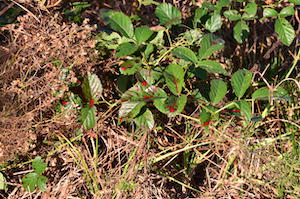
Broad-leafed plants like these briars display blood more readily than grasses and fennel as this picture makes obvious.
If assiduous efforts in this manner fail to enlighten the tracker, four other methods can be attempted. Again, recognize that these techniques carry the risk of clouding the true sign and should only be employed as a last resort (except in certain circumstances).
A circular search pattern is initiated around the last sign. The first circle may keep the sign within two feet of the tracker. The thickness of the terrain dictates the diameter of the successive circles. Typically, each circle is only a few feet wider than the proceeding one. Since the animal was unmistakably at the last sign each circle should somewhere cross its trail.
Sometimes the terrain offers a limited number of possible routes and each of these can be scouted for indications the animal passed or proof that it did not. For instance, mud and sand show tracks or the lack of tracks. Thick briar patches manifest bends and pulls. Depending upon the time interval, intact spider webs also indicate no passage.
To speed up the tracking process with multiple trackers, one can remain on the last sure sign and the others range ahead to likely places to intercept the trail. Also, if the place where the animal’s flight was last heard has not been yet reached, the tracker can try that locale or direct a companion to it. Sometimes listening from the shot site to a helper rustling bushes can enable the hunter to pinpoint the location.
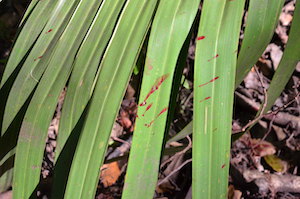
Blood droplets not only show where the game passed but also the direction it headed—here to the left.
A grid pattern can be employed to search for the animal or sign. Again, the thickness of the terrain determines the spacing of the paths the searcher or searchers will follow. For ease, typically a north/south and east/west pattern is utilized, but this is not truly important. If a distant landmark can keep the tracks separate and steady, any orientation is fine.
Much tracking is performed at night with the aid of flashlights or lanterns. It should be noted that while flashlight beams directed forward from the tracker highlight blood very effectively, the same orientation diminishes the perception of tracks. Therefore, it is best to alternate between a beam forward and a beam from the side to reveal the most sign. Even in the day, sometimes changing the tracker’s position relative to the sun will highlight tracks or blood.
By the way, the more familiar a hunter is with the natural terrain, the easier for him or her to see where it has been disrupted. Tracking unwounded animals during the off-season, or when scouting, is an enjoyable way for trackers to advance their skills, gaining experience when the loss of a game animal is not at stake. It is worth adding too, that the biggest aid to blood trailing is to create the best trail. This is a combination of many factors including making a great shot, choosing shot angles that require the least penetration to effectuate a pass-through, and using bows, arrows, and broadheads suitable to the game targeted.
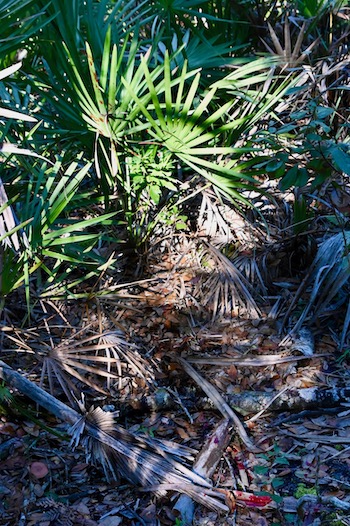
Note not only the blood on the ground but also that on the waist-high palmettos. Game that ignores easier pathways and pushes through encumbrances is often gravely injured.
Like traditional archery itself, tracking requires a great deal of knowledge, dedication, and practice. A page or two in a magazine can provide some guidelines and ideas, but further study is paramount; certain terrains present unusual challenges, blood sign’s appearance alters with age, trails themselves weather, stricken animals may reverse directions, and some wounds require special approaches. My book, Tales of Trails—Finding the Game After the Shot, (available through 3Rivers Archery and elsewhere), delves comprehensively into all aspects of tracking wounded game and is a beneficial source of information for all hunters, novices to veterans alike.


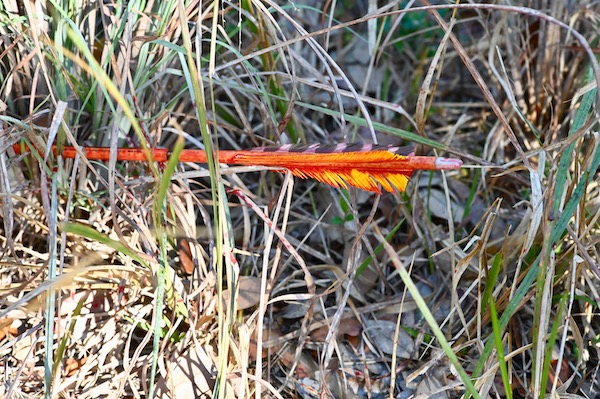

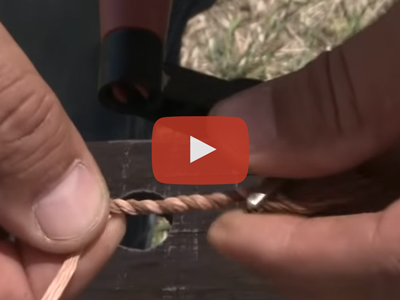
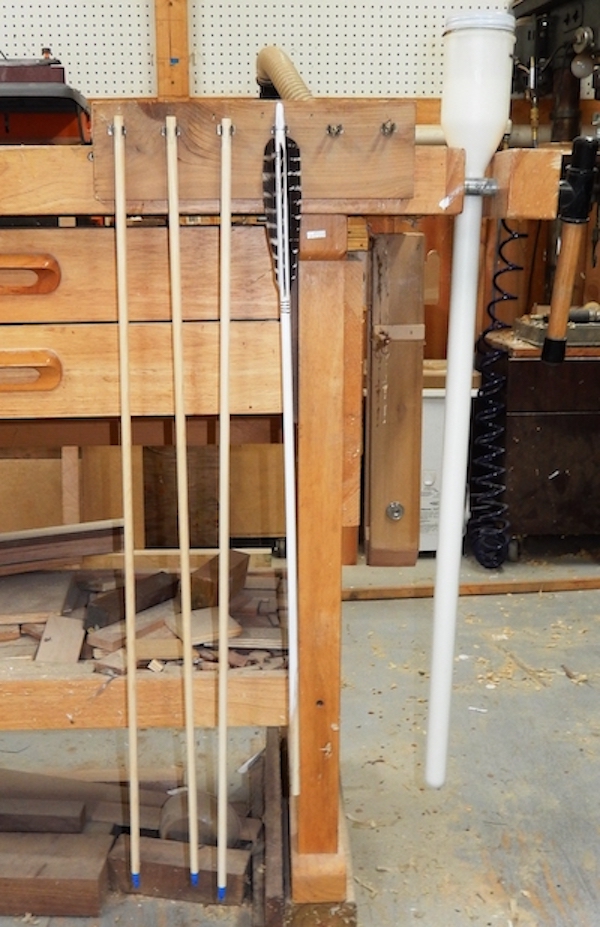

Leave A Comment